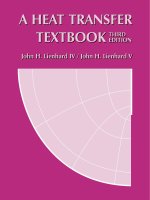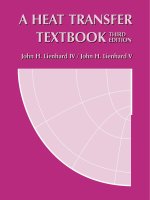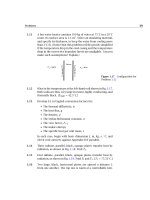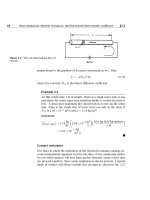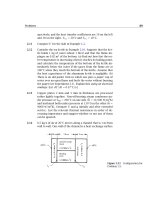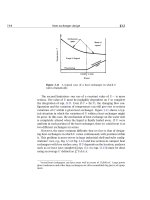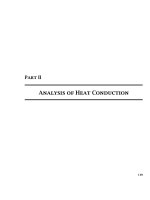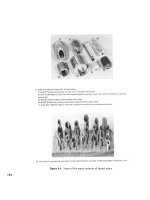Heat transfer textbook 3rd edition ~ team tolly
Bạn đang xem bản rút gọn của tài liệu. Xem và tải ngay bản đầy đủ của tài liệu tại đây (8.4 MB, 762 trang )
A HEAT TRANSFER
TEXTBOOK
THIRD
EDITION
John H. Lienhard IV / John H. Lienhard V
A HEAT TRANSFER
TEXTBOOK
THIRD
EDITION
John H. Lienhard IV / John H. Lienhard V
A Heat Transfer Textbook
A Heat Transfer Textbook
Third Edition
by
John H. Lienhard IV
and
John H. Lienhard V
Phlogiston
Press
Cambridge
Massachusetts
Professor John H. Lienhard IV
Department of Mechanical Engineering
University of Houston
4800 Calhoun Road
Houston TX 77204-4792 U.S.A.
Professor John H. Lienhard V
Department of Mechanical Engineering
Massachusetts Institute of Technology
77 Massachusetts Avenue
Cambridge MA 02139-4307 U.S.A.
Copyright ©2006 by John H. Lienhard IV and John H. Lienhard V
All rights reserved
Please note that this material is copyrighted under U.S. Copyright Law. The
authors grant you the right to download and print it for your personal use or
for non-profit instructional use. Any other use, including copying,
distributing or modifying the work for commercial purposes, is subject to the
restrictions of U.S. Copyright Law. International copyright is subject to the
Berne International Copyright Convention.
The authors have used their best efforts to ensure the accuracy of the
methods, equations, and data described in this book, but they do not
guarantee them for any particular purpose. The authors and publisher offer
no warranties or representations, nor do they accept any liabilities with
respect to the use of this information. Please report any errata to the authors.
Lienhard, John H., 1930–
A heat transfer textbook / John H. Lienhard IV and
John H. Lienhard V — 3rd ed. — Cambridge, MA :
Phlogiston Press, c2006
Includes bibliographic references and index.
1. Heat—Transmission 2. Mass Transfer
I. Lienhard, John H., V, 1961– II. Title
TJ260.L445 2006
Published by Phlogiston Press
Cambridge, Massachusetts, U.S.A.
This book was typeset in Lucida Bright and Lucida New Math fonts (designed
by Bigelow & Holmes) using L
A
T
E
X under the Y&Y T
E
X System.
For updates and information, visit:
/>This copy is:
Version 1.24 dated January 22, 2006
Preface
This book is meant for students in their introductory heat transfer course
— students who have learned calculus (through ordinary differential equa-
tions) and basic thermodynamics. We include the needed background in
fluid mechanics, although students will be better off if they have had
an introductory course in fluids. An integrated introductory course in
thermofluid engineering should also be a sufficient background for the
material here.
Our major objectives in rewriting the 1987 edition have been to bring
the material up to date and make it as clear as possible. We have substan-
tially revised the coverage of thermal radiation, unsteady conduction,
and mass transfer. We have replaced most of the old physical property
data with the latest reference data. New correlations have been intro-
duced for forced and natural convection and for convective boiling. The
treatment of thermal resistance has been reorganized. Dozens of new
problems have been added. And we have revised the treatment of turbu-
lent heat transfer to include the use of the law of the wall. In a number of
places we have rearranged material to make it flow better, and we have
made many hundreds of small changes and corrections so that the text
will be more comfortable and reliable. Lastly, we have eliminated Roger
Eichhorn’s fine chapter on numerical analysis, since that topic is now
most often covered in specialized courses on computation.
This book reflects certain viewpoints that instructors and students
alike should understand. The first is that ideas once learned should not
be forgotten. We have thus taken care to use material from the earlier
parts of the book in the parts that follow them. Two exceptions to this
are Chapter 10 on thermal radiation, which may safely be taught at any
point following Chapter 2, and Chapter 11 on mass transfer, which draws
only on material through Chapter 8.
v
vi
We believe that students must develop confidence in their own ability
to invent means for solving problems. The examples in the text therefore
do not provide complete patterns for solving the end-of-chapter prob-
lems. Students who study and absorb the text should have no unusual
trouble in working the problems. The problems vary in the demand that
they lay on the student, and we hope that each instructor will select those
that best challenge their own students.
The first three chapters form a minicourse in heat transfer, which is
applied in all subsequent chapters. Students who have had a previous
integrated course thermofluids may be familiar with this material, but
to most students it will be new. This minicourse includes the study of
heat exchangers, which can be understood with only the concept of the
overall heat transfer coefficient and the first law of thermodynamics.
We have consistently found that students new to the subject are greatly
encouraged when they encounter a solid application of the material, such
as heat exchangers, early in the course. The details of heat exchanger de-
sign obviously require an understanding of more advanced concepts —
fins, entry lengths, and so forth. Such issues are best introduced after
the fundamental purposes of heat exchangers are understood, and we
develop their application to heat exchangers in later chapters.
This book contains more material than most teachers can cover in
three semester-hours or four quarter-hours of instruction. Typical one-
semester coverage might include Chapters 1 through 8 (perhaps skipping
some of the more specialized material in Chapters 5, 7, and 8), a bit of
Chapter 9, and the first four sections of Chapter 10.
We are grateful to the Dell Computer Corporation’s STAR Program,
the Keck Foundation, and the M.D. Anderson Foundation for their partial
support of this project.
JHL IV, Houston, Texas
JHL V, Cambridge, Massachusetts
August 2003
Contents
I The General Problem of Heat Exchange 1
1 Introduction 3
1.1 Heat transfer 3
1.2 Relation of heat transfer to thermodynamics 6
1.3 Modes of heat transfer 10
1.4 A look ahead 35
1.5 Problems 36
Problems 37
References 46
2 Heat conduction concepts, thermal resistance, and the overall
heat transfer coefficient
49
2.1 The heat diffusion equation 49
2.2 Solutions of the heat diffusion equation 58
2.3 Thermal resistance and the electrical analogy 62
2.4 Overall heat transfer coefficient, U 78
2.5 Summary 86
Problems 86
References 96
3 Heat exchanger design 99
3.1 Function and configuration of heat exchangers 99
3.2 Evaluation of the mean temperature difference in a heat
exchanger
103
3.3 Heat exchanger effectiveness 120
3.4 Heat exchanger design 126
Problems 129
References 136
vii
viii Contents
II Analysis of Heat Conduction 139
4 Analysis of heat conduction and some steady one-dimensional
problems
141
4.1 The well-posed problem 141
4.2 The general solution 143
4.3 Dimensional analysis 150
4.4 An illustration of dimensional analysis in a complex steady
conduction problem
159
4.5 Fin design 163
Problems 183
References 190
5 Transient and multidimensional heat conduction 193
5.1 Introduction 193
5.2 Lumped-capacity solutions 194
5.3 Transient conduction in a one-dimensional slab 203
5.4 Temperature-response charts 208
5.5 One-term solutions 218
5.6 Transient heat conduction to a semi-infinite region 220
5.7 Steady multidimensional heat conduction 235
5.8 Transient multidimensional heat conduction 247
Problems 252
References 265
III Convective Heat Transfer 267
6 Laminar and turbulent boundary layers 269
6.1 Some introductory ideas 269
6.2 Laminar incompressible boundary layer on a flat surface 276
6.3 The energy equation 292
6.4 The Prandtl number and the boundary layer thicknesses 296
6.5 Heat transfer coefficient for laminar, incompressible flow
over a flat surface
300
6.6 The Reynolds analogy 311
6.7 Turbulent boundary layers 313
6.8 Heat transfer in turbulent boundary layers 322
Problems 330
References 338
Contents ix
7 Forced convection in a variety of configurations 341
7.1 Introduction 341
7.2 Heat transfer to and from laminar flows in pipes 342
7.3 Turbulent pipe flow 355
7.4 Heat transfer surface viewed as a heat exchanger 367
7.5 Heat transfer coefficients for noncircular ducts 370
7.6 Heat transfer during cross flow over cylinders 374
7.7 Other configurations 384
Problems 386
References 393
8 Natural convection in single-phase fluids and during film
condensation
397
8.1 Scope 397
8.2 The nature of the problems of film condensation and of
natural convection
398
8.3 Laminar natural convection on a vertical isothermal
surface
401
8.4 Natural convection in other situations 416
8.5 Film condensation 428
Problems 443
References 452
9 Heat transfer in boiling and other phase-change configurations 457
9.1 Nukiyama’s experiment and the pool boiling curve 457
9.2 Nucleate boiling 464
9.3 Peak pool boiling heat flux 472
9.4 Film boiling 486
9.5 Minimum heat flux 488
9.6 Transition boiling and system influences 489
9.7 Forced convection boiling in tubes 496
9.8 Forced convective condensation heat transfer 505
9.9 Dropwise condensation 506
9.10 The heat pipe 509
Problems 513
References 517
x Contents
IV Thermal Radiation Heat Transfer 523
10 Radiative heat transfer 525
10.1 The problem of radiative exchange 525
10.2 Kirchhoff’s law 533
10.3 Radiant heat exchange between two finite black bodies . 536
10.4 Heat transfer among gray bodies 549
10.5 Gaseous radiation 563
10.6 Solar energy 574
Problems 584
References 592
V Mass Transfer 595
11 An introduction to mass transfer 597
11.1 Introduction 597
11.2 Mixture compositions and species fluxes 600
11.3 Diffusion fluxes and Fick’s law 608
11.4 Transport properties of mixtures 614
11.5 The equation of species conservation 627
11.6 Mass transfer at low rates 635
11.7 Steady mass transfer with counterdiffusion 648
11.8 Mass transfer coefficients at high rates of mass transfer . 654
11.9 Simultaneous heat and mass transfer 663
Problems 673
References 686
VI Appendices 689
A Some thermophysical properties of selected materials 691
References 694
B Units and conversion factors 721
References 722
C Nomenclature 725
Citation Index 733
Subject Index 739
Part I
The General Problem of Heat
Exchange
1
1. Introduction
The radiation of the sun in which the planet is incessantly plunged, pene-
trates the air, the earth, and the waters; its elements are divided, change
direction in every way, and, penetrating the mass of the globe, would raise
its temperature more and more, if the heat acquired were not exactly
balanced by that which escapes in rays from all points of the surface and
expands through the sky. The Analytical Theory of Heat, J. Fourier
1.1 Heat transfer
People have always understood that something flows from hot objects to
cold ones. We call that flow heat. In the eighteenth and early nineteenth
centuries, scientists imagined that all bodies contained an invisible fluid
which they called caloric. Caloric was assigned a variety of properties,
some of which proved to be inconsistent with nature (e.g., it had weight
and it could not be created nor destroyed). But its most important feature
was that it flowed from hot bodies into cold ones. It was a very useful
way to think about heat. Later we shall explain the flow of heat in terms
more satisfactory to the modern ear; however, it will seldom be wrong to
imagine caloric flowing from a hot body to a cold one.
The flow of heat is all-pervasive. It is active to some degree or another
in everything. Heat flows constantly from your bloodstream to the air
around you. The warmed air buoys off your body to warm the room you
are in. If you leave the room, some small buoyancy-driven (or convective)
motion of the air will continue because the walls can never be perfectly
isothermal. Such processes go on in all plant and animal life and in the
air around us. They occur throughout the earth, which is hot at its core
and cooled around its surface. The only conceivable domain free from
heat flow would have to be isothermal and totally isolated from any other
region. It would be “dead” in the fullest sense of the word — devoid of
any process of any kind.
3
4 Introduction §1.1
The overall driving force for these heat flow processes is the cooling
(or leveling) of the thermal gradients within our universe. The heat flows
that result from the cooling of the sun are the primary processes that we
experience naturally. The conductive cooling of Earth’s center and the ra-
diative cooling of the other stars are processes of secondary importance
in our lives.
The life forms on our planet have necessarily evolved to match the
magnitude of these energy flows. But while “natural man” is in balance
with these heat flows, “technological man”
1
has used his mind, his back,
and his will to harness and control energy flows that are far more intense
than those we experience naturally. To emphasize this point we suggest
that the reader make an experiment.
Experiment 1.1
Generate as much power as you can, in some way that permits you to
measure your own work output. You might lift a weight, or run your own
weight up a stairwell, against a stopwatch. Express the result in watts (W).
Perhaps you might collect the results in your class. They should generally
be less than 1 kW or even 1 horsepower (746 W). How much less might
be surprising.
Thus, when we do so small a thing as turning on a 150 W light bulb,
we are manipulating a quantity of energy substantially greater than a
human being could produce in sustained effort. The power consumed
by an oven, toaster, or hot water heater is an order of magnitude beyond
our capacity. The power consumed by an automobile can easily be three
orders of magnitude greater. If all the people in the United States worked
continuously like galley slaves, they could barely equal the output of even
a single city power plant.
Our voracious appetite for energy has steadily driven the intensity
of actual heat transfer processes upward until they are far greater than
those normally involved with life forms on earth. Until the middle of the
thirteenth century, the energy we use was drawn indirectly from the sun
1
Some anthropologists think that the term Homo technologicus (technological man)
serves to define human beings, as apart from animals, better than the older term Homo
sapiens (man, the wise). We may not be as much wiser than the animals as we think we
are, but only we do serious sustained tool making.
§1.1 Heat transfer 5
using comparatively gentle processes — animal power, wind and water
power, and the combustion of wood. Then population growth and defor-
estation drove the English to using coal. By the end of the seventeenth
century, England had almost completely converted to coal in place of
wood. At the turn of the eighteenth century, the first commercial steam
engines were developed, and that set the stage for enormously increased
consumption of coal. Europe and America followed England in these
developments.
The development of fossil energy sources has been a bit like Jules
Verne’s description in Around the World in Eighty Days in which, to win
a race, a crew burns the inside of a ship to power the steam engine. The
combustion of nonrenewable fossil energy sources (and, more recently,
the fission of uranium) has led to remarkably intense energy releases in
power-generating equipment. The energy transferred as heat in a nuclear
reactor is on the order of one million watts per square meter.
A complex system of heat and work transfer processes is invariably
needed to bring these concentrations of energy back down to human pro-
portions. We must understand and control the processes that divide and
diffuse intense heat flows down to the level on which we can interact with
them. To see how this works, consider a specific situation. Suppose we
live in a town where coal is processed into fuel-gas and coke. Such power
supplies used to be common, and they may return if natural gas supplies
ever dwindle. Let us list a few of the process heat transfer problems that
must be solved before we can drink a glass of iced tea.
• A variety of high-intensity heat transfer processes are involved with
combustion and chemical reaction in the gasifier unit itself.
• The gas goes through various cleanup and pipe-delivery processes
to get to our stoves. The heat transfer processes involved in these
stages are generally less intense.
• The gas is burned in the stove. Heat is transferred from the flame to
the bottom of the teakettle. While this process is small, it is intense
because boiling is a very efficient way to remove heat.
• The coke is burned in a steam power plant. The heat transfer rates
from the combustion chamber to the boiler, and from the wall of
the boiler to the water inside, are very intense.
6 Introduction §1.2
• The steam passes through a turbine where it is involved with many
heat transfer processes, including some condensation in the last
stages. The spent steam is then condensed in any of a variety of
heat transfer devices.
• Cooling must be provided in each stage of the electrical supply sys-
tem: the winding and bearings of the generator, the transformers,
the switches, the power lines, and the wiring in our houses.
• The ice cubes for our tea are made in an electrical refrigerator. It
involves three major heat exchange processes and several lesser
ones. The major ones are the condensation of refrigerant at room
temperature to reject heat, the absorption of heat from within the
refrigerator by evaporating the refrigerant, and the balancing heat
leakage from the room to the inside.
• Let’s drink our iced tea quickly because heat transfer from the room
to the water and from the water to the ice will first dilute, and then
warm, our tea if we linger.
A society based on power technology teems with heat transfer prob-
lems. Our aim is to learn the principles of heat transfer so we can solve
these problems and design the equipment needed to transfer thermal
energy from one substance to another. In a broad sense, all these prob-
lems resolve themselves into collecting and focusing large quantities of
energy for the use of people, and then distributing and interfacing this
energy with people in such a way that they can use it on their own puny
level.
We begin our study by recollecting how heat transfer was treated in
the study of thermodynamics and by seeing why thermodynamics is not
adequate to the task of solving heat transfer problems.
1.2 Relation of heat transfer to thermodynamics
The First Law with work equal to zero
The subject of thermodynamics, as taught in engineering programs, makes
constant reference to the heat transfer between systems. The First Law
of Thermodynamics for a closed system takes the following form on a
§1.2 Relation of heat transfer to thermodynamics 7
Figure 1.1 The First Law of Thermodynamics for a closed system.
rate basis:
Q
positive toward
the system
= Wk
positive away
from the system
+
dU
dt
positive when
the system’s
energy increases
(1.1)
where Q is the heat transfer rate and Wk is the work transfer rate. They
may be expressed in joules per second (J/s) or watts (W). The derivative
dU/dt is the rate of change of internal thermal energy, U, with time, t.
This interaction is sketched schematically in Fig.
1.1a.
The analysis of heat transfer processes can generally be done with-
out reference to any work processes, although heat transfer might sub-
sequently be combined with work in the analysis of real systems. If pdV
work is the only work occuring, then eqn. (
1.1)is
Q = p
dV
dt
+
dU
dt
(1.2a)
This equation has two well-known special cases:
Constant volume process: Q =
dU
dt
= mc
v
dT
dt
(1.2b)
Constant pressure process: Q =
dH
dt
= mc
p
dT
dt
(1.2c)
where H ≡ U + pV is the enthalpy, and c
v
and c
p
are the specific heat
capacities at constant volume and constant pressure, respectively.
When the substance undergoing the process is incompressible (so that
V is constant for any pressure variation), the two specific heats are equal:
8 Introduction §1.2
c
v
= c
p
≡ c. The proper form of eqn. (1.2a) is then
Q =
dU
dt
= mc
dT
dt
(1.3)
Since solids and liquids can frequently be approximated as being incom-
pressible, we shall often make use of eqn. (
1.3).
If the heat transfer were reversible, then eqn. (
1.2a) would become
2
T
dS
dt
Q
rev
= p
dV
dt
Wk
rev
+
dU
dt
(1.4)
That might seem to suggest that Q can be evaluated independently for in-
clusion in either eqn. (
1.1)or(1.3). However, it cannot be evaluated using
TdS, because real heat transfer processes are all irreversible and S is not
defined as a function of T in an irreversible process. The reader will recall
that engineering thermodynamics might better be named thermostatics,
because it only describes the equilibrium states on either side of irre-
versible processes.
Since the rate of heat transfer cannot be predicted using TdS, how
can it be determined? If U(t) were known, then (when Wk = 0) eqn. (
1.3)
would give Q, but U(t) is seldom known a priori.
The answer is that a new set of physical principles must be introduced
to predict Q. The principles are transport laws, which are not a part of
the subject of thermodynamics. They include Fourier’s law, Newton’s law
of cooling, and the Stefan-Boltzmann law. We introduce these laws later
in the chapter. The important thing to remember is that a description
of heat transfer requires that additional principles be combined with the
First Law of Thermodynamics.
Reversible heat transfer as the temperature gradient vanishes
Consider a wall connecting two thermal reservoirs as shown in Fig.
1.2.
As long as T
1
>T
2
, heat will flow spontaneously and irreversibly from 1
to 2. In accordance with our understanding of the Second Law of Ther-
modynamics, we expect the entropy of the universe to increase as a con-
sequence of this process. If T
2
→ T
1
, the process will approach being
quasistatic and reversible. But the rate of heat transfer will also approach
2
T = absolute temperature, S = entropy, V = volume, p = pressure, and “rev” denotes
a reversible process.
§1.2 Relation of heat transfer to thermodynamics 9
Figure 1.2 Irreversible heat flow
between two thermal reservoirs through
an intervening wall.
zero if there is no temperature difference to drive it. Thus all real heat
transfer processes generate entropy.
Now we come to a dilemma: If the irreversible process occurs at
steady state, the properties of the wall do not vary with time. We know
that the entropy of the wall depends on its state and must therefore be
constant. How, then, does the entropy of the universe increase? We turn
to this question next.
Entropy production
The entropy increase of the universe as the result of a process is the sum
of the entropy changes of all elements that are involved in that process.
The rate of entropy production of the universe,
˙
S
Un
, resulting from the
preceding heat transfer process through a wall is
˙
S
Un
=
˙
S
res 1
+
˙
S
wall
= 0, since S
wall
must be constant
+
˙
S
res 2
(1.5)
where the dots denote time derivatives (i.e.,
˙
x ≡ dx/dt). Since the reser-
voir temperatures are constant,
˙
S
res
=
Q
T
res
. (1.6)
Now Q
res 1
is negative and equal in magnitude to Q
res 2
, so eqn. (
1.5)
becomes
˙
S
Un
=
Q
res 1
1
T
2
−
1
T
1
. (1.7)
10 Introduction §1.3
The term in parentheses is positive, so
˙
S
Un
> 0. This agrees with Clau-
sius’s statement of the Second Law of Thermodynamics.
Notice an odd fact here: The rate of heat transfer, Q, and hence
˙
S
Un
,
is determined by the wall’s resistance to heat flow. Although the wall
is the agent that causes the entropy of the universe to increase, its own
entropy does not change. Only the entropies of the reservoirs change.
1.3 Modes of heat transfer
Figure
1.3 shows an analogy that might be useful in fixing the concepts
of heat conduction, convection, and radiation as we proceed to look at
each in some detail.
Heat conduction
Fourier’s law. Joseph Fourier (see Fig.
1.4) published his remarkable
book Théorie Analytique de la Chaleurin 1822. In it he formulated a very
complete exposition of the theory of heat conduction.
Hebegan his treatise by stating the empirical law that bears his name:
the heat flux,
3
q (W/m
2
), resulting from thermal conduction is proportional
to the magnitude of the temperature gradient and opposite to it in sign.If
we call the constant of proportionality, k, then
q =−k
dT
dx
(1.8)
The constant, k, is called the thermal conductivity. It obviously must have
the dimensions W/m·K, or J/m·s·K, or Btu/h·ft·
◦
F if eqn. (
1.8)istobe
dimensionally correct.
The heat flux is a vector quantity. Equation (
1.8) tells us that if temper-
ature decreases with x, q will be positive—it will flow in the x-direction.
If T increases with x, q will be negative—it will flow opposite the x-
direction. In either case, q will flow from higher temperatures to lower
temperatures. Equation (
1.8) is the one-dimensional form of Fourier’s
law. We develop its three-dimensional form in Chapter 2, namely:
q =−k ∇T
3
The heat flux, q, is a heat rate per unit area and can be expressed as Q/A, where A
is an appropriate area.
Figure 1.3 An analogy for the three modes of heat transfer.
11
Figure 1.4 Baron Jean Baptiste Joseph Fourier (1768–1830). Joseph
Fourier lived a remarkable double life. He served as a high govern-
ment official in Napoleonic France and he was also an applied mathe-
matician of great importance. He was with Napoleon in Egypt between
1798 and 1801, and he was subsequently prefect of the administra-
tive area (or “Department”) of Isère in France until Napoleon’s first
fall in 1814. During the latter period he worked on the theory of
heat flow and in 1807 submitted a 234-page monograph on the sub-
ject. It was given to such luminaries as Lagrange and Laplace for
review. They found fault with his adaptation of a series expansion
suggested by Daniel Bernoulli in the eighteenth century. Fourier’s
theory of heat flow, his governing differential equation, and the now-
famous “Fourier series” solution of that equation did not emerge in
print from the ensuing controversy until 1822. (Etching from Por-
traits et Histoire des Hommes Utiles, Collection de Cinquante Portraits,
Société Montyon et Franklin 1839-1840).
12
§1.3 Modes of heat transfer 13
Example 1.1
The front of a slab of lead (k = 35 W/m·K) is kept at 110
◦
C and the
back is kept at 50
◦
C. If the area of the slab is 0.4 m
2
and it is 0.03 m
thick, compute the heat flux, q, and the heat transfer rate, Q.
Solution. For the moment, we presume that dT /dx is a constant
equal to (T
back
− T
front
)/(x
back
− x
front
); we verify this in Chapter
2.
Thus, eqn. (
1.8) becomes
q =−35
50 −110
0.03
=+70, 000 W/m
2
= 70 kW/m
2
and
Q = qA = 70(0.4) = 28 kW
In one-dimensional heat conduction problems, there is never any real
problem in deciding which way the heat should flow. It is therefore some-
times convenient to write Fourier’s law in simple scalar form:
q = k
∆T
L
(1.9)
where L is the thickness in the direction of heat flow and q and ∆T are
both written as positive quantities. When we use eqn. (
1.9), we must
remember that q always flows from high to low temperatures.
Thermal conductivity values. It will help if we first consider how con-
duction occurs in, for example, a gas. We know that the molecular ve-
locity depends on temperature. Consider conduction from a hot wall to
a cold one in a situation in which gravity can be ignored, as shown in
Fig.
1.5. The molecules near the hot wall collide with it and are agitated
by the molecules of the wall. They leave with generally higher speed and
collide with their neighbors to the right, increasing the speed of those
neighbors. This process continues until the molecules on the right pass
their kinetic energy to those in the cool wall. Within solids, comparable
processes occur as the molecules vibrate within their lattice structure
and as the lattice vibrates as a whole. This sort of process also occurs,
to some extent, in the electron “gas” that moves through the solid. The
